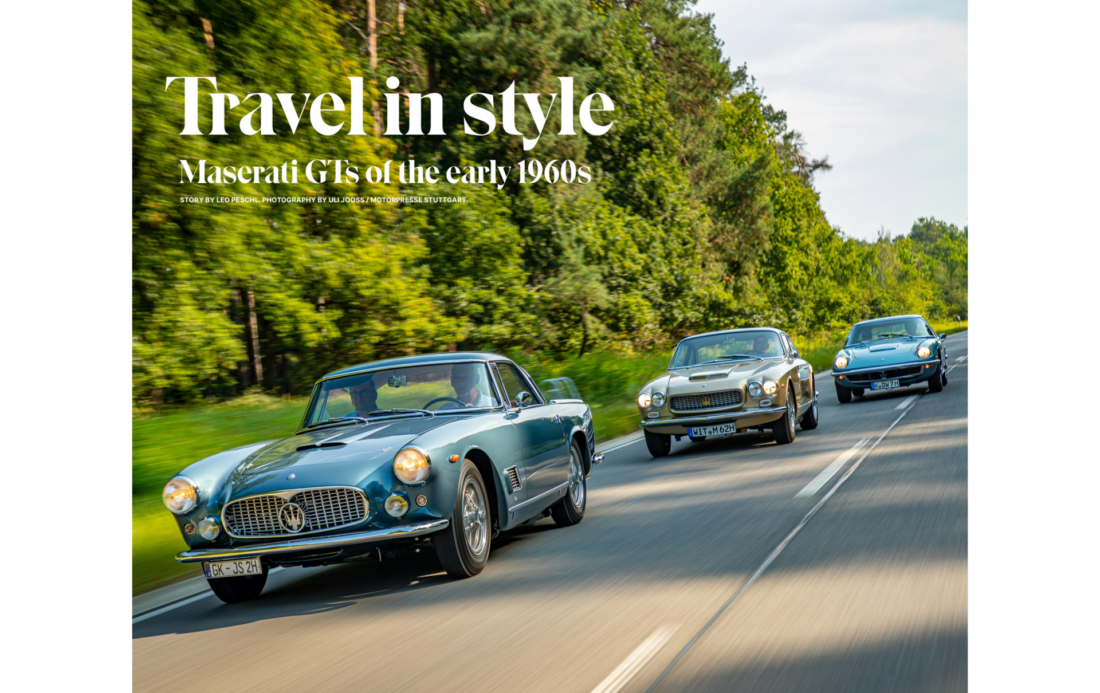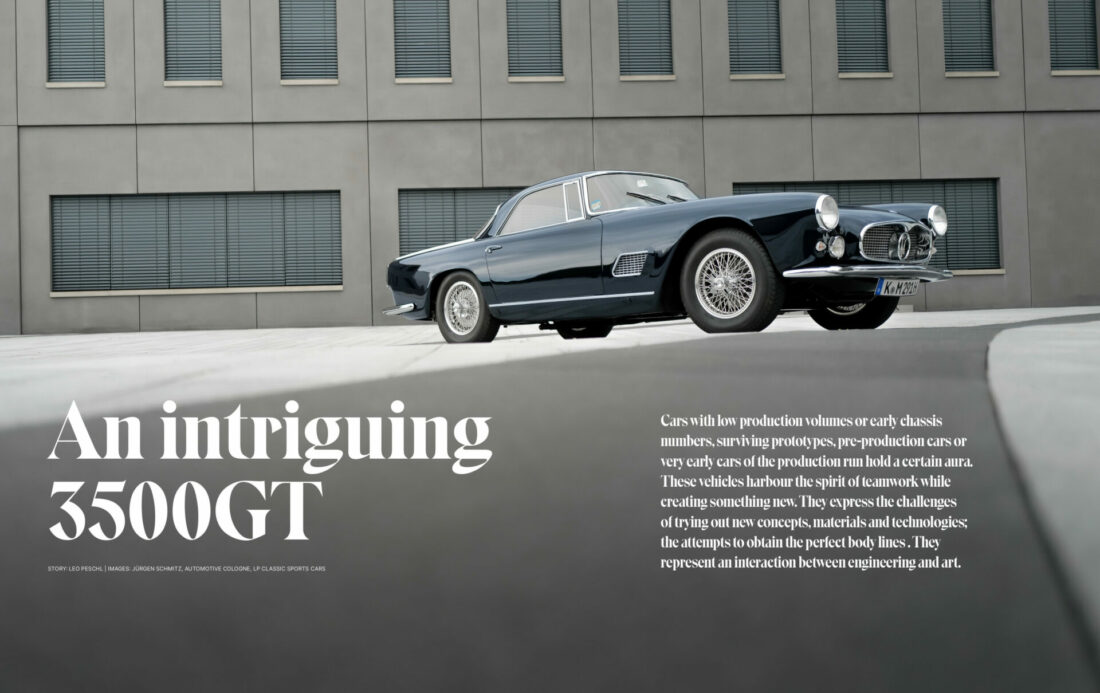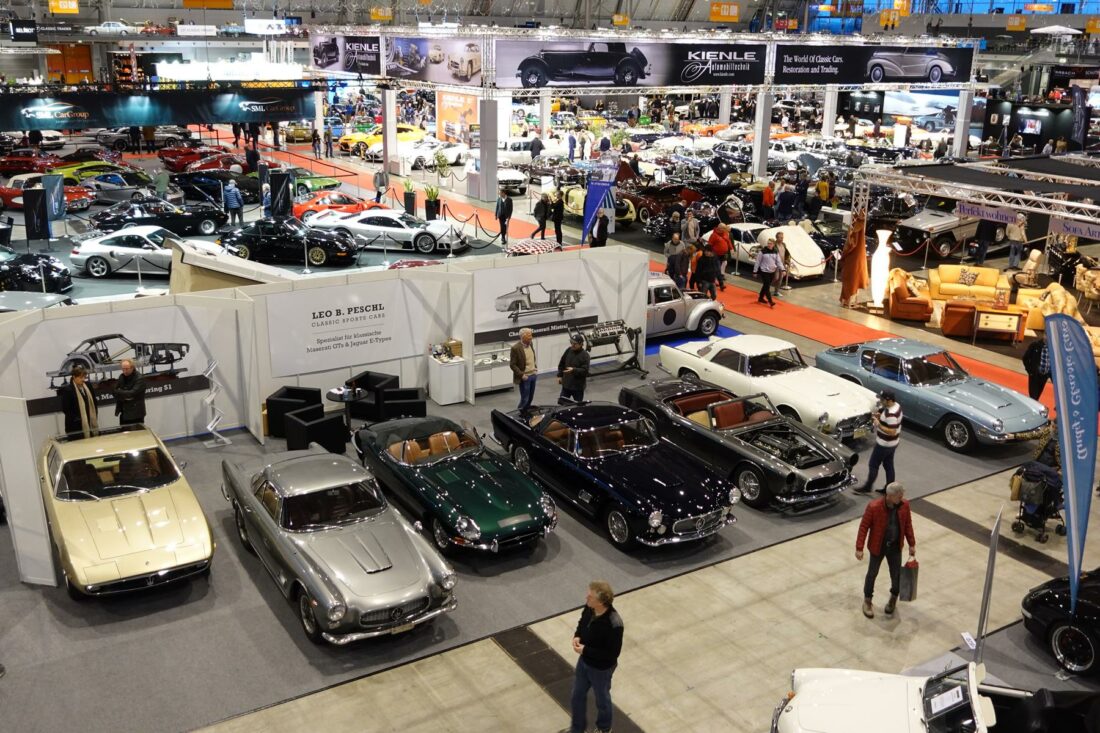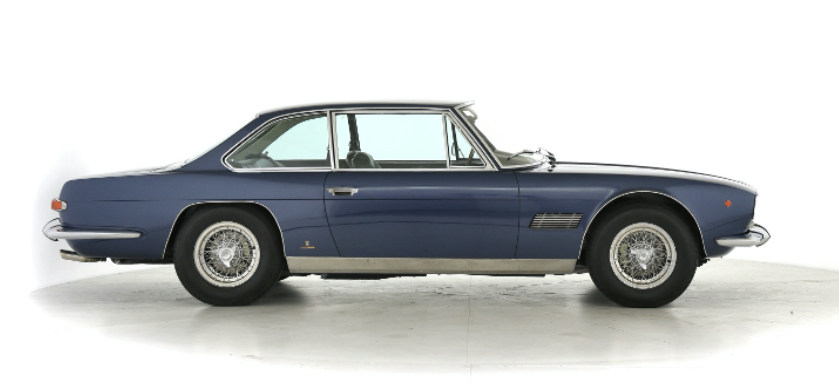
Travel in style – Maserati GTs of the early 1960s
As a car enthusiast in the ‘60s searching for a new car, with some money to spend on beautiful tailor-made bodywork and extravagant design, you had a unique range of opportunities.
Looking at the history, we can identify several factors contributing to this fruitful ground for building the most beautiful, most aesthetic and at the same time also the most complex and artistic car bodies of all time.
For the first time, the most well-known coachbuilders had potent engines at their disposal. Enabling them to dress the chassis frames with more extravaganza and roomy curvature. Weight, the limiting factor of the past, did not play such a role any more. The body designers and coachbuilders could now focus on shapes, design ideas and lavish interiors without limitations.
It was a long time before safety regulations, economic considerations, and practicality began to overrule creativity. In the early 1960s, labour rates in Italy were meagre compared to other countries in Europe.
This circumstance supported labour-intensive creations and handcraft. It allowed the manufacturing of minimal numbers of hand-built pieces of art, very complex body structures and tailor-made coachwork.

In the early 1960s Italian coachbuilders handcrafted the most beautiful, extravagant pieces of art.
Two decades after the war, European societies were becoming more prosperous. And by now, it became acceptable again to spend money on beautiful objects, for example, extravagant cars.
These parameters set the framework for Italian coachbuilders to give the world the most beautiful, extravagant handcrafted pieces of art, when elsewhere, exclusive motor cars like Jaguar or Porsche became highly engineered and larger-scale industrial products.
When considering a Maserati GT in the early ‘60s, you could choose between three models: Maserati 3500GT(i), Maserati Sebring and Maserati Mistral. All technically very similar, with a dramatically different appearance. The most important and well known Italian coachbuilders were responsible for their coachwork: Carozzeria Touring (3500GT/ GTi), Carozzeria Vignale (Sebring), Carozzeria Frua (Mistral).
A potential customer could choose between three distinct, unique and, at the same time, exceptionally tasteful body shapes. Similar for all three models are the front and rear suspension designs, the Maserati 6-cylinder twin-cam engine mated to the ZF gearbox and the LUCAS fuel injection system.The feeling and the impressive driving experience combined with the overall visual appeal are induced by the different chassis and body structures. Plenty of reasons to learn more about the Carozzerias.
MASERATI 3500GT/GTI BY TOURING
Touring developed its famous Superleggera concept in the late 1930s. Following the motto of Carlo Felice Bianchi Anderloni, the founder of Touring: ‘weight is the enemy; air resistance the challenge’; this concept builds a skeleton made of thin steel tubes covered with beautifully shaped alloy panels. Touring gradually integrated front and rear fenders and mudguards into fully closed coachwork throughout the 1940s. With the Alfa Romeo 1900SS bodywork’s appearance, the later form of the 3500GT began to evolve.
The 3500GT was introduced in 1957 and became the first large volume model for Maserati and their first real Grand Touring car, built on the Superleggera concept. When opening a door, hood or trunk lid, you immediately sense this concept. The fine shut lines, lightweight panels, and artistic strokes anticipate the driving experience
MASERATI SEBRING BY VIGNALE

Many of the successful Vignale bodies were designed by Giovanni Michelotti. This is also true for the Maserati Sebring. Vignale, as a coachbuilder, gained a reputation for developing body structures with exceptional torsional stiffness and strength. Almost all bodies were built out of steel characterised by massive sills, multi-layer, profiled bulkheads and high beltlines. This is the generic blueprint for this car’s driving experience: low seating, very stable driving, vigorous cornering, negligible roll.
A prominent external design element is the double front lights, first applied on the Alfa Romeo 2000 coachwork in 1960-61 and on the Lancia Flavia Convertible. Delicately blended with the high beltline, this feature gives the car a truly aggressive stance.
MASERATI MISTRAL BY FRUA

Pietro Frua worked as a designer for various manufacturers. He introduced some very remarkable design elements for the Mistral. The large glass surfaces, connected with a low beltline, the glass dome on the rear boot lid, the front bumper and the radiator grille – the first time an air inlet was placed under the front bumper.
In contrast to the Vignale designed Sebring’s full steel structure, the body structure of the Maserati Mistral follows the Touring approach: a chassis made of steel tubes, sheet steel, and stiffening reinforcements wrapped with a skilfully crafted alloy skin.
The Maserati Mistral represents a beautiful blend between the two former designs, light, easy handling, torsional stiffness and a wide glasshouse-like interior.
From all models with 6-cylinder double ignition, the Mistral is the most rewarding and most comfortable to drive.
DRIVING EXPERIENCE
There is one specific sensation you will enjoy regardless of the body design: its marvellous Maserati 6-cylinder twin-cam engine. At idle, it runs without vibrations with a deep and pleasant growl, while at higher revs, it turns into an aggressive and powerful sound, blending a turbine’s sonance with a true race engine.
Power delivery is super smooth; only your discipline will stop you from revving the engine and shiftimpression. The seat cushions are comfortable and spacious, without much side support. The overall impression of the interior is elegance, nobility, space, plush.
The car is a GT, so it likes long roads and curves; it is not a vehicle made for sharp hairpins and small streets. The car sits stable on the road while it adapts to changes in road surfaces. Yet, the driving experience remains suitably soft and wholly ing into the next higher gear. Flexibility is nothing short of remarkable; acceleration from low speeds in 5th gear is achieved without blinking an eye. The Maserati engine is the heart and soul of these cars.
When you’re sitting behind the steering wheel of a Maserati 3500GTi, you see an instrument panel representing a piece of art: chrome framed instruments arranged in a painted panel, a large beautiful steering wheel with chrome inserts. The thin gear lever fits well and supports the delicate driving predictable. The 3500GTi does not feel sporty, and due to its rather vertically placed windscreen, wind noise is present, though never disturbing. Overall, the 3500GT/GTi lives from its beautiful exterior and interior design elements; it is wonderful to look at. It is the design icon of the three cars.
Getting into a Maserati SEBRING is easy; the doors are wide, the seats are spacious and very comfortable, there is almost unlimited legroom.
One sits deeper than in the 3500GT/GTi and immediately feels the high waistline. The cabin feels protective, solid and rigid. Due to the all-steel envelop and robust chassis design, there is substantially less engine vibration and noise. It all feels more cocooning and solid.
The upholstery is attractive, the interior is highly luxurious, with soft padding everywhere. A display of several round dials makes the instrument panel look impressive, a skilful blend of sporty features.
The car corners beautifully, and due to its shorter wheelbase (2500 mm vs 2600 mm for the Touring car), you may adopt a more sporty driving style. The ride feels firm and is entirely devoid of shake and rattle. It not only looks more aggressive but also performs that way. Of the three models in this comparison, the racing pedigree is best felt in a Sebring.
From all models with 6-cylinder double ignition, the Maserati MISTRAL is the most rewarding and most comfortable to drive. It has the best power-to-weight ratio, the smoothest steering and the most pleasant and light interior. The seating position is comfortable, with a little less space than in the Sebring, but lower and more supportive.
The aluminium body is superbly finished, window frames and doors fit perfectly and close with a delightful, high-quality sound. The wheelbase is further reduced to 2400 mm, but the cabin layout conveys a much brighter atmosphere and allows considerably more space for driver and passenger due to the large windows and the low waistline.
The body lines are impressive – especially when the car is on 16 “wheels with original spec tires. The beauty, elegance and sportiness of the body can best be seen when the car can be viewed in a large, empty space. It is the choice of the driver and connoisseur.
My motive for penning this article is my profound admiration and passion for classic Maserati GTs.
I am sincerely impressed by these cars’ aura, their elegant lines, and the craftsmanship behind the coachwork and the manufacturing of these cars. Every Maserati of this period is a piece of art, tailor-made, unique and specific. It has been a privilege to restore these cars and revive them to factory standards. It is a substantial challenge that requires passion, skill, devotion and persistence. The result is a concours-quality classic Maserati GT, a marvel to drive and an intense pleasure to own.


















